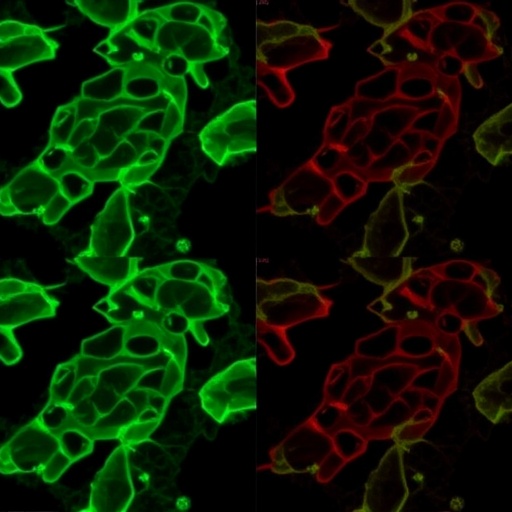The increasing prevalence of polycystic ovary syndrome (PCOS), a multifaceted endocrine disorder affecting approximately 10% of women globally, has become a major public health concern. Recent research led by Tao, Yan, and Wang explores critical molecular pathways that may elucidate the pathogenesis of this complex syndrome. Their investigation centers on the interaction of non-coding RNA KRTAP5-AS1, the microRNA miR-199b-5p, and the gene CYP19A1, highlighting the mechanistic associations between these elements and their potential roles in PCOS development. Understanding these intricate biological interactions could pave the way for novel therapeutic approaches and diagnostic strategies, thereby improving the quality of life for millions of affected women.
In their seminal study published in the Journal of Ovarian Research, the researchers identify a significant correlation between elevated KRTAP5-AS1 levels and the pathophysiological features of PCOS. This long non-coding RNA has been implicated in various cellular processes, including transcription regulation and chromatin remodeling. By analyzing tissue samples from PCOS patients, the researchers report heightened expression of KRTAP5-AS1, which appears to exert influence over the downstream targets, including miR-199b-5p. The association between KRTAP5-AS1 and miR-199b-5p suggests a regulatory loop that warrants further exploration.
The role of miR-199b-5p, a small non-coding RNA, has garnered significant attention in recent years. It is known to modulate gene expression by binding to complementary sequences within target messenger RNAs, leading to translational repression or degradation. In the context of PCOS, the study reveals that miR-199b-5p levels are inversely related to the activity of CYP19A1, the gene encoding aromatase, an essential enzyme for estrogen biosynthesis. This feedback mechanism highlights a critical axis in the hormonal dysregulation often observed in PCOS patients.
Aromatase is pivotal in converting androgens into estrogens, and its dysregulation can lead to hyperandrogenism, a hallmark of PCOS. The authors present compelling evidence suggesting that increased expression of KRTAP5-AS1 results in elevated levels of miR-199b-5p, ultimately repressing CYP19A1 expression. This mechanistic insight provides a clearer understanding of the endocrine disturbances that characterize the syndrome and reveals potential targets for future interventions.
Moreover, the findings indicate that the KRTAP5-AS1/miR-199b-5p/CYP19A1 axis may serve as a biomarker for predicting the onset of PCOS. Early identification of at-risk populations could facilitate timely interventions, mitigating long-term complications associated with the disorder, such as infertility and metabolic syndrome. Furthermore, such a biomarker would serve as a tool for clinicians to monitor disease progression and treatment responses in affected patients.
In addition to its biological significance, the study conducted by Tao et al. contributes to the broader field of non-coding RNA research. Non-coding RNAs, including long non-coding RNAs such as KRTAP5-AS1 and small microRNAs like miR-199b-5p, have emerged as key regulators of gene expression in multiple biological contexts. Their study reinforces the notion that these molecules are not merely transcriptional noise but rather crucial players in cellular signaling pathways.
The implications of this research extend beyond the realm of reproductive health. The interplay between hormonal regulation and non-coding RNAs suggests broader applications in understanding other endocrine disorders, metabolic pathologies, and even oncogenic processes. As future studies continue to unravel the complexities of non-coding RNAs, the potential for novel therapeutic targets within these pathways is vast.
It is essential to acknowledge the limitations of the current study as well. While the authors provide a robust dataset supporting their hypothesis, additional longitudinal studies are necessary to confirm the findings and elucidate causational relationships. Furthermore, the role of environmental factors and lifestyle choices, which may contribute to the etiology of PCOS, necessitates comprehensive exploration in correlating these findings with a more diverse population.
The exploration of the KRTAP5-AS1/miR-199b-5p/CYP19A1 axis marks an exciting avenue of research in the realm of reproductive endocrinology. Not only does it provide insights into the molecular underpinnings of PCOS, but it also stimulates ongoing dialogue about the role of non-coding RNAs in various pathophysiological states. The potential for these findings to inspire clinical applications in the management of PCOS and perhaps other related conditions is a tantalizing prospect.
In conclusion, the work of Tao, Yan, and Wang underscores the sophisticated nature of PCOS and the importance of investigating non-coding RNA pathways in understanding its etiology. The elucidation of the KRTAP5-AS1/miR-199b-5p/CYP19A1 axis not only enriches our scientific knowledge but also equips healthcare professionals with novel insights to improve patient care. Unlocking the secrets of non-coding RNAs may usher in a new era of personalized medicine, where treatments are tailored based on individual molecular profiles, ultimately transforming the landscape of reproductive health.
As research moves forward, we anticipate further studies that will build upon these findings, potentially revealing additional layers of complexity in the interplay between genetic, epigenetic, and environmental factors influencing the pathogenesis of PCOS. By continuing to explore these relationships, the scientific community can inch closer to providing effective solutions to combat the challenges posed by this prevalent syndrome.
The implications of this research will undoubtedly resonate within the scientific community for years to come. As new methodologies and technologies emerge, the possibilities for unraveling the mysteries of complex diseases like PCOS are boundless. As we move toward a future where the intersection of genetics and personalized medicine becomes increasingly pronounced, the contributions of studies like that of Tao et al. will serve as essential cornerstones in shaping that trajectory.
With the promise of molecular insights offering pathways toward innovative treatments, the fight against polycystic ovary syndrome may witness more profound changes in therapeutic strategies. The revelations brought to light by this research are a call to action for continued exploration within the exciting field of reproductive health, underscoring the critical importance of understanding the molecular basis of diseases that impact the lives of countless individuals around the world.
Subject of Research: The mechanistic role of the KRTAP5-AS1/miR-199b-5p/CYP19A1 axis in polycystic ovary syndrome pathogenesis.
Article Title: Mechanistic role of the KRTAP5-AS1/miR-199b-5p/CYP19A1 axis in polycystic ovary syndrome pathogenesis.
Article References:
Tao, P., Yan, X. & Wang, Z. Mechanistic role of the KRTAP5-AS1/miR-199b-5p/CYP19A1 axis in polycystic ovary syndrome pathogenesis.
J Ovarian Res 18, 176 (2025). https://doi.org/10.1186/s13048-025-01746-8
Image Credits: AI Generated
DOI: 10.1186/s13048-025-01746-8
Keywords: Polycystic ovary syndrome, KRTAP5-AS1, miR-199b-5p, CYP19A1, non-coding RNA, endocrine disorder.
Tags: CYP19A1 gene interactiondiagnostic strategies for PCOSelevated KRTAP5-AS1 levelsendocrine disorders in womenKRTAP5-AS1 non-coding RNAmiR-199b-5p microRNA rolemolecular pathways in PCOSpathophysiological features of PCOSpolycystic ovary syndrome researchregulatory loops in gene expressiontherapeutic approaches for PCOSwomen’s health and PCOS





